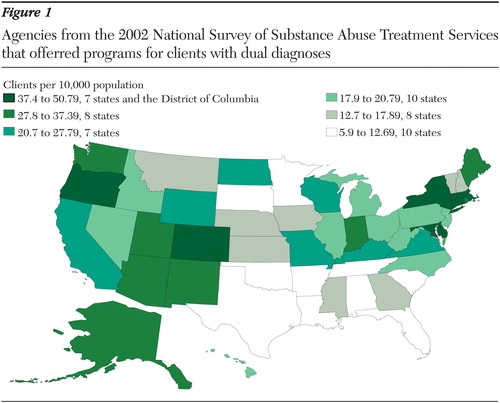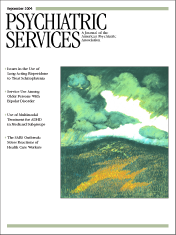Datapoints: Service Availability for Persons With Co-occurring Conditions
Persons who seek treatment for substance use disorders often have co-occurring mental health problems. Inconveniently, public-sector funds are often separated for substance abuse treatment and mental health services. The rise of Medicaid managed care during the past decade may have further complicated the provision of services for persons with co-occurring conditions. Our study examined time trends and geographic variation of public-sector programs for clients with dual diagnoses and the impact of managed care on these programs.
Data were obtained from the 2000 and the 2002 National Survey of Substance Abuse Treatment Services and their predecessors, the 1997 and the 1998 Uniform Facility Data Set (1,2). These surveys included more than 90 percent of the 13,000 addiction treatment agencies in the United States that receive public funds. In addition to providing data on agency organizational and financial relationships, respondents were asked to estimate the facility caseload on the day of the survey.
The percentage of agencies that offered programs for clients with dual diagnoses changed little, if at all, over time (48 percent in 1997, compared with 49 percent in 2002). As shown in Figure 1, data from the 2002 survey showed marked geographic variation in the availability of these programs. An analysis of the 2002 data with logistic regression models stratified by state showed that agencies were more likely to offer these programs if they received Medicaid payments, had agreements with managed care organizations, were larger, were hospital based, or provided outpatient non-methadone treatment (all p<.001). For-profit agencies and methadone clinics were less likely to offer these programs (p<.001 and p<.05, respectively). The interaction term for Medicaid and managed care was not significant. The mean±SD facility caseload was found to be 80±126 for facilities that did not provide programs for persons with dual diagnoses and 100±186 for facilities that did provide such services.
Marked geographic variation exists in the availability of publicly funded substance abuse treatment services that offer these programs. Arrangements with managed care and Medicaid as well as larger agency size and not-for-profit status are associated with the provision of special services for persons with co-occurring conditions.
Acknowledgments
This study was supported in part by the Robert Wood Johnson Foundation and the National Institute on Alcohol Abuse and Alcoholism.
Dr. McFarland is affiliated with the department of psychiatry at the Oregon Health and Science University, Mail Code CR-139, Portland, Oregon 97239 (e-mail, [email protected]). Dr. Gabriel is with RMC Research Corporation in Portland, Oregon. Harold Alan Pincus, M.D., and Terri L. Tanielian, M.A., are editors of this column.

Figure 1. Agencies from the 2002 National Survey of Substance Abuse Treatment Services that offerred programs for clients with dual diagnoses
1. National Survey of Substance Abuse Treatment Services (N-SSATS):2000 and 2002, Data on Substance Abuse Treatment Facilities. Rockville, Md, Substance Abuse and Mental Health Services Administration, Office of Applied Studies, 2002 and 2003. Available at www.icpsr.umich.edu/SAMHDAGoogle Scholar
2. Uniform Facility Data Set (UFDS):1997 and 1998, Data on Substance Abuse Treatment Facilities. Rockville, Md, Substance Abuse and Mental Health Services Administration, Office of Applied Studies, 1999 and 2000. Available at www.icpsr.umich.edu/SAMHDAGoogle Scholar



